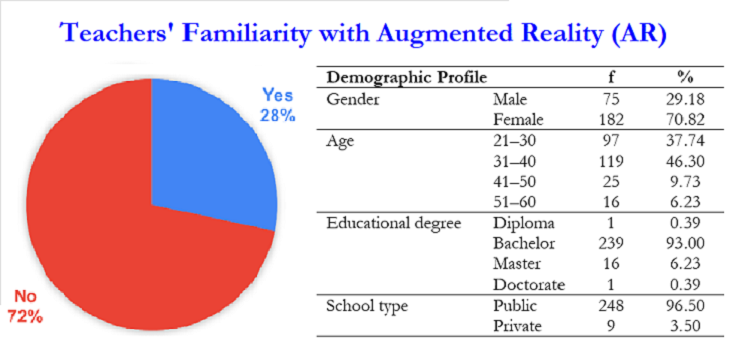
Using Augmented Reality for Geometry Learning: Indonesian Elementary School Teachers' Experiences
Abstract
This study aims to discover Indonesian elementary school teachers' experiences (n = 257) of using Augmented Reality (AR) for learning, especially related to one of the topics in mathematics learning, namely, geometry. AR is considered to be an alternative instructional media that can be utilized for teaching geometry, including the topic of three-dimensional shapes. A questionnaire consisting of both close-ended and open-ended questions was used to collect data in this study. This study has successfully revealed teachers' use of digital instructional media during the COVID-19 pandemic, their familiarity with AR, frequency of AR use for geometry learning, and challenges in using it.
Keywords
Full Text:
PDFReferences
Ahmad, N. I. N., & Junaini, S. N. (2020). Augmented reality for learning mathematics: A systematic literature review. International Journal of Emerging Technologies in Learning (iJET), 15(16), 106–122. https://doi.org/10.3991/ijet.v15i16.14961
Akçayır, M., & Akçayır, G. (2017). Advantages and challenges associated with augmented reality for education: A systematic review of the literature. Educational Research Review, 20, 1–11. https://doi.org/10.1016/j.edurev.2016.11.002
Alalwan, N., Cheng, L., Al-Samarraie, H., Yousef, R., Alzahrani, A. I., & Sarsam, S. M. (2020). Challenges and prospects of virtual reality and augmented reality utilization among primary school teachers: A developing country perspective. Studies in Educational Evaluation, 66, 100876. https://doi.org/10.1016/j.stueduc.2020.100876
Alkhattabi, M. (2017). Augmented reality as e-learning tool in primary schools' education: Barriers to teachers' adoption. International Journal of Emerging Technologies in Learning (iJET), 12(2), 91–100. https://doi.org/10.3991/ijet.v12i02.6158
Alzahrani, N. M. (2020). Augmented reality: A systematic review of its benefits and challenges in e-learning contexts. Applied Sciences, 10(16), 5660. https://doi.org/10.3390/app10165660
Andrea, R., Lailiyah, S., Agus, F., & Ramadiani, R. (2019). “Magic Boosed” an elementary school geometry textbook with marker-based augmented reality. TELKOMNIKA (Telecommunication Computing Electronics and Control), 17(3), 1242–1249. http://doi.org/10.12928/telkomnika.v17i3.11559
Ashley-Welbeck, A., & Vlachopoulos, D. (2020). Teachers’ perceptions on using augmented reality for language learning in primary years programme (PYP) education. International Journal of Emerging Technologies in Learning (iJET), 15(12), 116–135. https://doi.org/10.3991/ijet.v15i12.13499
Azuma, R., Baillot, Y., Behringer, R., Feiner, S., Julier, S., & MacIntyre, B. (2001). Recent advances in augmented reality. IEEE computer graphics and applications, 21(6), 34–47. https://doi.org/10.1109/38.963459
Cohen, L., Manion, L., & Morrison, K. (2018). Research methods in education (8th ed.). London, England: Routledge.
Creswell, J. W. (2014). Educational research: Planning, conducting, and evaluating quantitative and qualitative research (5th ed.). Sydney, Australia: Pearson Education, Inc.
Demitriadou, E., Stavroulia, K. E., & Lanitis, A. (2020). Comparative evaluation of virtual and augmented reality for teaching mathematics in primary education. Education and Information Technologies, 25, 381–401. https://doi.org/10.1007/s10639-019-09973-5
Foulger, T. S., Graziano, K. J., Schmidt-Crawford, D., & Slykhuis, D. A. (2017). Teacher educator technology competencies. Journal of Technology and Teacher Education, 25(4), 413–448.
Garzón, J., Pavón, J., & Baldiris, S. (2019). Systematic review and meta-analysis of augmented reality in educational settings. Virtual Reality, 23(4), 447–459. https://doi.org/10.1007/s10055-019-00379-9
Gecu-Parmaksiz, Z., & Delialioglu, O. (2019). Augmented reality-based virtual manipulatives versus physical manipulatives for teaching geometric shapes to preschool children. British Journal of Educational Technology, 50(6), 3376–3390. https://doi.org/https://doi.org/10.1111/bjet.12740
Herrera, L. M., Pérez, J. C., & Ordóñez, S. J. (2019). Developing spatial mathematical skills through 3D tools: augmented reality, virtual environments and 3D printing. International Journal on Interactive Design and Manufacturing (IJIDeM), 13, 1385–1399. https://doi.org/10.1007/s12008-019-00595-2
Ibáñez, M. B., Di Serio, Á., Villarán, D., & Kloos, C. D. (2014). Experimenting with electromagnetism using augmented reality: Impact on flow student experience and educational effectiveness. Computers & Education, 71, 1–13. https://doi.org/10.1016/j.compedu.2013.09.004
Jamrus, M. H. M., & Razali, A. B. (2021). Acceptance, readiness and intention to use augmented reality (AR) in teaching English reading among secondary school teachers in Malaysia. Asian Journal of University Education, 17(4), 312–326. https://doi.org/10.24191/ajue.v17i4.16200
Ozdamli, F., & Karagozlu, D. (2018). Preschool teachers’ opinions on the use of augmented reality application in preschool science education. Croatian Journal of Education, 20(1), 43–74. https://doi.org/10.15516/cje.v20i1.2626
Tzima, S., Styliaras, G., & Bassounas, A. (2019). Augmented reality applications in education: Teachers point of view. Education Sciences, 9(2), 99. https://doi.org/10.3390/educsci9020099
Jurnal Pendidikan Sains Journal of Science, Mathematics, and Vocational Education Graduate School Of Universitas Negeri Malang JPS is licensed under Creative Commons Attribution-ShareAlike 4.0 International License |






